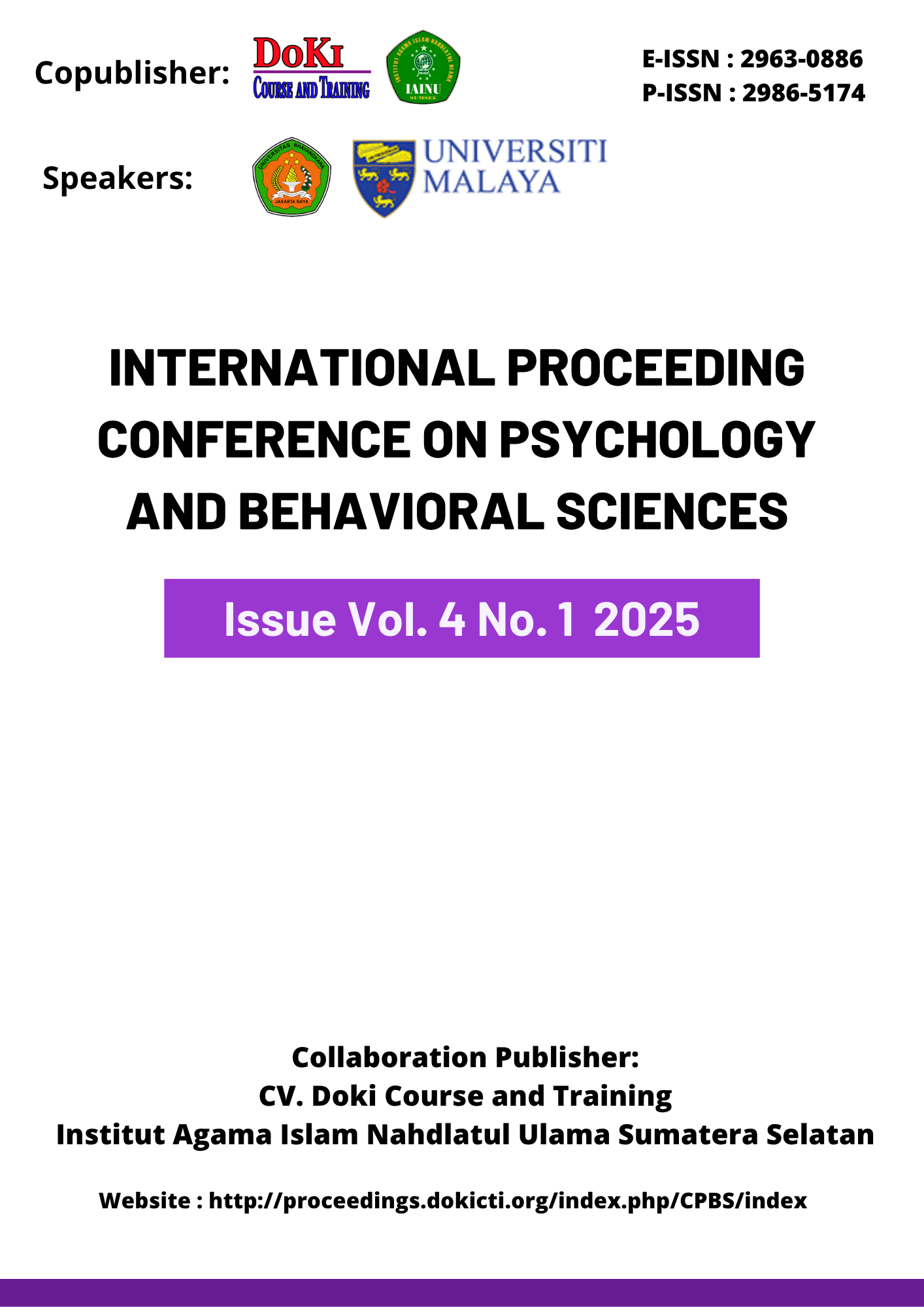The Effect of Qur'anic Murottal Therapy on Academic Stress of College Students in Palembang City
DOI:
https://doi.org/10.61994/cpbs.v4i1.214Keywords:
Islamic Psychotherapy, Murottal Al-Qur'an, Academic Stress, College StudentsAbstract
This study aims to examine the effect of Qur'anic murottal therapy on academic stress in university students in Palembang City. The method used in this study was a quasi-experimental method with a one group Pre-test-Post-test design involving students with a total of 44 respondents from various universities in Palembang City. Data were collected using a Google Form questionnaire containing a validated academic stress scale instrument with a total of 24 statement items which were then analyzed using the Wilcoxon non-parametric statistical test. The results showed no difference before and after the treatment of murottal therapy of Al-Qur'an Surah Ar-Rahman was given (p = 0.573 < 0.05). Therefore, it can be interpreted that there is no effect of Qur'anic murottal therapy on academic stress in students in Palembang City. The research findings contain differences in the results of research conducted by researchers with previous studies which state that there is an influence between Qur'anic murottal therapy on academic stress. Therefore, the researcher reviews various factors that influence the difference in these results, as well as things that are weaknesses in this study.
References
Agolla, J. E. & Ongori, H. (2009). An Assessment of Academic Stress Among Undergraduate Students: The Case of University of Botswana. Educational Research and Review, 4(2), 63- 70. http://www.academicjournals.org/ERR
Alam, K. B. (2016). The Qur'anic Psychotheraphy Approach in Mental Health Disorders (A Study of Islamic Psychology). Journal of Islamic Communication and Education, 6(1). 132-154. https://journal.staimsyk.ac.id/index.php/almanar/issue/view/15
Aristovnik, A., Kerzic, D., Ravseli, D., Tomazevic, N., & Umek, L. (2020). Impacts of the COVID19 Pandemic on Life of Higher Education Students: A Global Perspective. Sustainability, 12(20). https://doi.org/10.3390/su12208438
Beiter, R., Nash, R., McCrady, M., Rhoades, D., Linscomb, M., Clarahan, M., & Sammut, S. (2015). The Prevalence and Correlates of Depression, Anxiety, and Stress in a Sample of College Students. Journal of Affective Disorders, 173, 90-96. https://doi.org/10.1016/j.jad.2014.10.054
Gunawan, H. & Maryam. (2022) Murottal Quran Surah Ar-Rahman Reduces Anxiety Level of Cataract Pre-Operation Patients. Nerz Muda, 3(2), 226-234. https://doi.org/10.26714/nm.v3i2.8974
Handayani, E.S. & Subakti, H. (2021). The Effect of Learning Discipline on Indonesian Language Learning Outcomes in Elementary Schools. Basicedu Journal, 5(1). 151-164. https://jbasic.org/index.php/basicedu
Ibrahim, A. K., Kelly, S. J., Adams, C. E., & Glazebrook, C. (2013). A Systematic Review of Studies of Depression Prevalence in University Students. Journal of Psychiatric Research, 47(3), 391400. https://doi.org/10.1016/j.jpsychires.2012.11.015
Jozaghi, E., Asadullah, M., & Dahya, A. (2016). The Role of Muslim Faith-Based Programs in Transforming the Lives of People Suffering with Mental Health and Addiction Problems. Journal of Substance Use, 21(6), 587-593. https://doi.org/10.3109/14659891.2015.1112851
Karim, Hamdi Abdul. (2021). Looking at the Management and Implementation of Worship as a Means of Psychotherapy in Islam. Al Irsyad, Journal of Islamic Counseling Guidance, 12(1), 15-36. https://ejournal.uinib.ac.id/jurnal/index.php/alirsyad/article/view/2710/1888
Keshavarzi, H., & Haque, A. (2013). Outlining a Psychotherapy Model for Enhancing Muslim Mental Health within an Islamic Context. International Journal for the Psychology of Religion, 23(3), 230-249. https://doi.org/10.1080/10508619.2012.712000
Khan, M. J., Altaf, S., & Kausar, H. (2013). Effect of Perceived Academic Stress on Students' Performance. FWU Journal of Social Sciences, 7(2), 146-151. http://dx.doi.org/10.4236/oalib.1103318
Marques, A. I., García, V., & Sánchez, J. S. (2013). A literature Review on the Application of Evolutionary Computing to Credit Scoring. Journal of the Operational Research Society, 64(9), 1384-1399. https://doi.org/10.1057/jors.2012.145
Misra, R., & Castillo, L. G. (2010). Academic Stress Among College Students: Comparison of American and International Students. International Journal of Stress Management, 11(2), 132-148. https://doi.org/10.1037/1072-5245.11.2.132
Pasaribu, B., et.al. (2024). Common Errors in Data Analysis: Normal and Abnormal Data. JIIP: Scientific Journal of Education Science, 7(3). 2413-2418. https://doi.org/10.61132/observasi.v2i4.542
Pascoe, M. C., Hetrick, S. E., & Parker, A. G. (2020). The Impact of Stress on Students in Higher Education: A Review of the Literature. International Journal of Adolescence and Youth, 25(1), 104-112. https://doi.org/10.1080/02673843.2019.1596823
Price, P. C., Jhangiani, R., & Chiang, I. C. A. (2015). Research Methods in Psychology (2nd Canadianed.). BCcampus. https://opentextbc.ca/researchmethodsfopsychology
Qudsyi, H. (2021). The Effect of Murottal Al-Qur'an on Stress Levels in Students of the Islamic University of Indonesia. Journal of Islamic Psychology, 8(2). http://www.jpi.apihimpsi.org/index.php/jpi/article/view/125
Rassool, G. H., & Khan, W. N. A. (2024). Hope in Islamic Psychotherapy. Journal of Spirituality in Mental Health, 26(3), 234-248. https://doi.org/10.1080/19349637.2023.2207751
Rothman, A., Betul Yucesoy, Z. & Yalcin, E., (2024) "Early Muslim Scholars' Conceptions of Character Development and Contemporary Applications in Mental Health and Well-being". Journal of Muslim Mental Health, 18(1): 4. 63-74. https://doi.org/10.3998/jmmh.6027
Shadiqi, A. M. (2023). Statistics for Psychology Research with SPSS. Depok, West Java: Raja Grafindo Persada.
Shamsuddin, K., Fadzil, F., Ismail, W. S. W., Shah, S. A., Omar, K., Muhammad, N. A., & Mahadevan, R. (2013). Correlates of Depression, Anxiety and Stress Among Malaysian University Students. Asian Journal of Psychiatry, 6(4), 318-323. https://doi.org/10.1016/j.ajp.2013.01.014
Solikhah, N. A. & Prawita, E. (2024). Development of Learning Stress Scale Instruments in New Students. Journal of Psychological Science Publications, 2(4), 38-47. https://doi.org/10.61132/observasi.v2i4.542
Stratton, S. J. (2019). Quasi-Experimental Design (Pre-test and Post-test Studies) in Prehospital and Disaster Research. Prehospital and Disaster Medicine, 34(6), 573-574. https://doi.org/10.1017/S1049023X19005053
Suryani, et.al. (2019). The Effect of Mind Mapping Method on Social Science Learning Outcomes of Fifth Grade Students of SDN No. 166 Inpres Bontorita Takalar Regency. Journal of Basic Education Studies, 4 (2). 741-753. https://journal.unismuh.ac.id/index.php/jkpd/article/view/2373
Ubaidillah, R., Anita, N. S., Nadina, A. J., Medina, A., & Kimi, A. R. F. (2025). The Effect of Murottal Al-Qur'an Therapy on Academic Stress Among University Students. Journal of Islamic Psychology and Behavioral Sciences, 3(2), 53-61. https://jurnal.dokicti.org/index.php/JIPBS/article/view/388
Zamroni, Z. (2015). Prevalence of Academic Stress among University Students. Psychoislamika:Journal of Islamic Psychology and Psychology, 12 (2), 51-58. https://doi.org/10.18860/psi.v12i2.6404
Downloads
Published
Issue
Section
License
Copyright (c) 2025 Nur Fadhilah, Alya Wirda Ningisih, Rinata Dewi Albaiti, Zahiri Marliansyah, Zaskia Putri Syahirah, Muh Ashar Gening, Dia Permata Ayu

This work is licensed under a Creative Commons Attribution-NonCommercial 4.0 International License.



